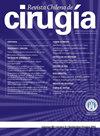冠状动脉旁路隐静脉的体外血管反应性和形态计量学研究:非接触技术与传统技术。
Q4 Medicine
引用次数: 1
摘要
导读:延长冠状动脉旁路移植术中移植物的通透性一直是一个挑战。目的:比较人隐静脉(VSH)“无接触”(NT)技术与常规技术(TC)在解剖和功能上的差异。材料与方法:实验研究。在安托法加斯塔地区医院心脏外科病房用CT和NT解剖VSH。VSH样品被切成3mm的环状,用克雷布斯-林格溶液保存在离体器官室中。为了评估血管舒缩活性,给予去甲肾上腺素(10-6M)、罂粟碱(10-4M)、乙酰胆碱(10-6M)和硝普钠(10-5M)。将一段样品固定在10%福尔马林中,用苏木精-伊红、Verhoeff和orceina光镜技术对其进行处理和组织学分析。采用Prism软件graphhad进行统计分析。结果:血管反应性:去甲肾上腺素诱导的血管收缩在NT组明显高于TC组(p < 0.0001)。NT组罂粟碱和乙酰胆碱的血管舒张作用分别高于对照组(p < 0.004)和对照组(p < 0.0003)。形态学研究:NT组肌层厚度(0.755 vs 0.680 mm)、非固定肌层厚度(0.5600 vs 0.4663 mm)、总壁厚度(1.344 vs 0.962 mm)均较TC组厚。血管数目无显著差异。结论:NT组血管收缩剂和血管舒张剂疗效显著。结果与形态学差异相关。关键词:隐静脉;冠状动脉搭桥术;有蒂的“出手”;血管损伤。本文章由计算机程序翻译,如有差异,请以英文原文为准。
Reactividad vascular in vitro y estudio morfométrico de venas safenas utilizadas como bypass coronario: técnica “no-touch” versus convencional.
Introduction: Prolonging of the grafts permeability used in coronary bypass is a constant challenge. Objective: To compare anatomical and functional human saphenous veins (VSH) extracted “No touch” (NT) technique vs conventional technique (TC). Materials and Methods: Experimental study. VSH dissected with CT and NT in the Regional Hospital of Antofagasta cardiac surgery ward. VSH samples were sectioned into 3 mm rings and preserved in isolated organs chambers with Krebs-Ringer solution. To evaluate the vasomotor activity, norepinephrine (10-6M), papaverine (10-4M), acetylcholine (10-6M) and sodium nitroprusside (10-5M) was administered. A segment of samples was fixed in 10% formalin, processed and histological analyzed under light microscopy technique with hematoxylin-eosin, Verhoeff and orceina. Statistical analysis was performed using the Prism software Graphad. Results: Vascular Reactivity: norepinephrine-induced vasoconstriction was significantly higher in the group rings NT vs TC (p < 0.0001). Vasodilation was higher with papaverine and acetylcholine in the NT group (p < 0.004) and (p < 0.0003), respectively. Morphometric study: The NT group presented muscularis (0.755 vs 0.680 mm), adventitious (0.5600 vs 0.4663 mm), and total wall (1.344 vs 0.962 mm) thicker than the TC group. No significant differences in vasa vasorum number identified. Conclusion: The NT group vasoconstrictor and vasodilator responds significantly better. Results correlate with morphometric differences. Key words: saphenous vein; coronary artery bypass; pedicled ‘no-touch’; vascular damage.
求助全文
通过发布文献求助,成功后即可免费获取论文全文。
去求助
来源期刊

Revista Chilena De Cirugia
Medicine-Surgery
CiteScore
0.20
自引率
0.00%
发文量
0
审稿时长
6-12 weeks
期刊介绍:
La Revista Chilena de Cirugía es un órgano de difusión del conocimiento y actividad quirúrgica. Su población objetivo son cirujanos, especialistas de otras áreas médicas, médicos generales y alumnos del área de la salud.
Sirve a cirujanos y otros especialistas, para publicar artículos originales e inéditos sobre temas médicos, en particular artículos de investigación básica y clínica, artículos de revisión, entre otros.
Buscan difundir y actualizar el conocimiento médico general y quirúrgico en particular. Se publica en forma bimestral.
La Revista Chilena de Cirugía está afiliada y patrocinada por la Sociedad de Cirujanos de Chilese desde el año 1952.
 求助内容:
求助内容: 应助结果提醒方式:
应助结果提醒方式:


